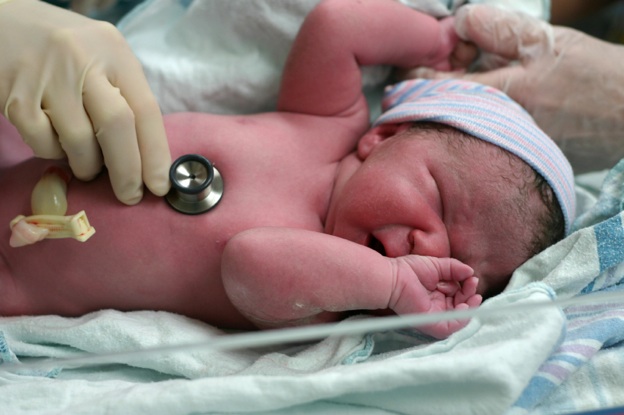SingaporeMotherhood | Baby & Toddler
August 2012
Newborn Tests That Your Baby Will Go Through

Immediately after he is born, your baby will undergo several tests and examinations. But you may be engrossed in meeting your baby for the first time (and perhaps too fatigued from labour) to take real notice of the examinations being performed. Nevertheless, taking an active role beforehand by finding out what the tests are and asking questions about them will help give you confidence as a new parent.
[banner][/banner]
Apgar Scoring
The Apgar score is a grading system used to assess newborns at one minute, then five minutes after birth. Your baby’s heart rate, breathing, muscle tone, reflexes and skin colour are assessed, and a score of zero, one, or two is given for each area. The total score is added, with 10 being the highest possible outcome. The first score is often lower than the second, because the newborn’s condition has improved with time or assistance.
The Apgar score is a quick, overall assessment, helping midwives and hospital staff identify babies who need immediate medical attention. It is important to realise that Apgar scores, while helpful, do not evaluate your baby’s overall health or predict long-term well-being.
Physical Examination
Immediately after birth, the midwife will perform a quick physical check on your baby, going through his body in a systematic crown-to-heel manner. Your baby’s weight, length, and head circumference will be taken and recorded in his Health Booklet, for future growth to be measured against.
Your newborn will also be examined by a paediatrician within the first 24 hours of life; the doctor will perform a more thorough physical exam, looking at your newborn’s:
• Head
• Face
• Chest
• Abdomen
• Genitals
• Anus
• Limbs
• Spine
The check will also include the baby’s heart function, breathing, and reflexes. Specific examinations will be carried out to pick up ‘clicky’ hips. This examination can be done in your presence, giving you the chance to clarify doubts and ask any questions you have.
Skin-to-skin Contact After Birth
In the first hour after birth, skin-to-skin contact with your baby offers numerous benefits for both you and your baby! Being in skin-to-skin contact establishes a natural, instinctive behaviour pattern between you and your newborn, promoting feelings of security and attachment. Your body has been your baby’s nest for many months, after all! You will also experience a surge in oxytocin levels, helping you to birth your placenta.
Ms Jani Combrink, nurse, a midwife and lactation consultant at prenatal and postnatal education centre Mother & Child, explains the benefits of skin-to-skin contact to babies.
She says, “Skin-to-skin contact offers benefits for healthy newborns as well as premature, underweight or sick babies. From temperature homeostasis to regulated heart rates and breathing, the list goes on. Childbirth may be medicated and controlled, possibly involving Caesarean sections. In these situations, skin-to-skin contact may be lifesaving for the baby, and relationship-building for the new family.”
Skin-to-skin contact also reduces crying and encourages your baby to initiate his first breastfeeding session in tune with his instincts.
To give your newly-birthed baby skin-to-skin closeness, place him on your chest, his tummy against yours, his cheek on your breast. Ask your birth attendants or the nurses to cover both of you with a warm blanket. Your body will keep your baby warm. Your husband can also provide this skin-to-skin closeness, if you are not able to.
Delaying Newborn Testing?
Lamaze International, an organisation which promotes the Lamaze method of childbirth, suggests delaying newborn testing until after the baby’s first breastfeeding session. Other birth professionals suggest waiting until after the first hour of baby’s birth. Examinations or procedures can be done while the baby is held in your arms. Discuss your preferences with your birth team before labour, and outline them in your birth plan.
Blood Test
Newborns routinely receive blood tests for blood grouping. They are also screened for G6PD, a deficiency in the enzymes required for normal functioning of red blood cells. Thyroid function tests are also performed. Testing for phenylketonuria, an enzyme deficiency, is done before seven days of age.
The paediatrician may suggest testing your baby’s jaundice levels based on clinical assessments. Paediatricians all over the world disagree on the standards for testing and treating jaundice. The World Health Organisation as well as international paediatric organisations suggest varying guidelines for the treatment of jaundice. Discuss your concerns with your baby’s doctor and ask about the guidelines he has in mind.
Newborn Metabolic Screen
You may choose to have a newborn metabolic screen. This screening determines if your baby is at low or high risk of developing metabolic disorders such as organic and fatty acid disorders. Over 99 per cent of babies fall into the ‘low risk’ category, although detecting and treating problems early averts potentially serious problems for babies with increased risk.
Tests to determine if your baby’s thyroid is functioning well or for G6PD are important, and should be done promptly. The American Academy of Pediatrics (AAP) recommends that your newborn be tested before discharge.
How Is It Done?
A few drops of blood are squeezed from the umbilical cord immediately after birth for blood grouping and the G6PD and thyroid tests. This does not cause any discomfort to your baby. If insufficient blood is obtained, for example when cord clamping is delayed, or when further samples are required to test for jaundice levels or for metabolic screening, a heel prick is performed.
In a heel prick, your baby’s heel is cleaned, and a small prick is made there. Blood is collected in a thin tube.
During the heel prick, some babies grimace or cry while others seem oblivious. It is difficult to measure the pain response in babies’ brains. All we can do is observe for crying, changes in heart rate or breathing has limitations.
Ms Combrink of Mother & Child suggests breastfeeding before, while the heel-prick tests are being done, and immediately after. “This can lower the baby’s pain-experience. The endorphins that are released in the baby’s brain while on the breast help a baby get through these sometimes painful experiences,” she explains.
During the later weeks of your pregnancy, meet with your baby’s paediatrician and discuss when testing will be done. Ask if you can be present with your baby or breastfeed at the same time. Discuss your preferences and negotiate. If you are unable to breastfeed throughout the procedure, breastfeeding before and after will still help.
Hearing Test
After birth, you can have your baby’s hearing screened. Hearing screening is painless and can be done easily. Any treatments would depend on what is causing the hearing loss.
It is recommended that you test your baby’s hearing soon after birth, before the age of three months. The ability to hear, and the learning of language are closely linked, and children pick up important language skills before they turn three. Newborn hearing impairment can also affect brain development. Being aware of hearing difficulties early means that your baby would receive early treatment and intervention.
DECISION MAKING FOR PARENTS
While most newborn tests are the norm, it is up to you, the parent, to seek answers if the paediatrician tells you that more tests are required.
When evaluating newborn tests, ask about your doctor’s:
• Goal
What is your doctor’s goal in performing the test? Is it to screen for abnormalities or is it to address a specific concern that he has? Is he trying to get more information to diagnose and treat a condition?
• Benefits
How will extra testing help your child?
• Drawbacks
What do the tests involve? How are they conducted? Will you be with your child? Are there any side-effects to the tests?
• Alternatives
Ask if there are other tests that may cause less discomfort for your baby but provide the same amount of helpful information.
• Timeframe
Can you wait to perform the test? If it is not urgent, you can adopt a ‘wait-and-watch’ approach or delay testing.
As new parents, it is important to ask questions, research your options and become informed. Discuss your paediatrician’s insights and work towards building a trusting partnership for your newborn’s care.
All content from this article, including images, cannot be reproduced without credits or written permission from SingaporeMotherhood.
Follow us on Facebook, Instagram, and Telegram for the latest article and promotion updates.






